#tropical lb
Text
love minori's expressions btw. girl is constantly like this

0 notes
Text
Just realized these 2 have this in common


#gif#pretty cure#pretty cure gif#gifs#precure#precure gif#magical girl#anime#cure papaya#tropical rouge pretty cure#tropicalpre#tropical rouge#tropical rouge precure#miraculous ladybug#nathalie sancoeur#miraculous#miraculous lb#miraculous lady bug#Miraculous ladybug gif#magical demigirl
8 notes
·
View notes
Text
as september is not that far off i finally bit the bullet and started s7...... you guys were Right abc 911's vibes are OFF. just watched that scene in ep2 where hen is talking with chim/eddie/buck about her suspension and they are looking at her all doubtful and not being reassuring enough..... what is this season doing to MY FAMILY.
#then again buck and eddie have been mwah so far#but then the fucking GANG??? on the CRUISE? and the bomb went off now and the tropical storm is coming...... worst two parter ever maybe#911 lb#911
11 notes
·
View notes
Text
i’m sorry i know 911 is a drama and creative liberty etc but they would NOT have sailed into a hurricane out of nowhere that quickly that would’ve been forecast for like at least 5-7 days 😭😭
#also a hurricane would NOT go from a nothing tropical storm to cat 5 that quickly 💀#anyway this is why i don’t watch weather episodes of shows 😂#well. i do obviously but i WILL complain about the incorrect meteorology the whole time#911 lb#911 spoilers
5 notes
·
View notes
Text
stumbles out of supervillain covered in blood
#gah. gahhhhhhhh. god#that was really good. god#i want to read tropical next but i think i needa break first. christ.#enstars tag#enstars lb
6 notes
·
View notes
Text
I miss Alex stalock. so much
#HAVING A MOMENT#ill get over it#wild lb#i see him leave the crease go on a tropical vacation i go oh i miss that
4 notes
·
View notes
Text
youtube
Ikaria Gummies Puradrop - The Weight Loss Solution. Tropical Gummy Hack: Dissolves 54 LBS of Fat!
#IkariaGummiesPuradrop#TropicalGummyHack#Dissolves54LBSofFat#BrokenMetabolism#DamagedMetabolism#Torch42lbswithTropicalGummyHack#Vanish42lbswithTropicalGummyHack#Eradicate42lbswithTropicalGummyHack#Torch 42 lbs of pure fat with Tropical Gummy Hack#Vanish 42 lbs of pure fat with Tropical Gummy Hack#Eradicate 42 lbs of pure fat with Tropical Gummy Hack#Weight loss results#Drop up to 2 Lbs a day#Warning about fast weight loss#Fixing a Broken Metabolism#Rabbit diets and their ineffectiveness#Challenges of#losing weight with salad diets#The problem with calorie restriction#Dealing with bullies#Rude Flight Attendant incident#Mom's situation on a plane#Woman removed from a plane due to weight-related issues#Gummy bears or lollipops for weight loss#Candy's role in weight loss#Gummy tricks for belly fat loss#Overnight fat melting with a single gummy#Harvard-approved candy for melting 54 lbs of fat#Harvard-endorsed sweet treat for dissolving 54 lbs of fat#Harvard-sanctioned candy for effortless fat dissolution
0 notes
Text




Ocean Sunfish or Common Mola (Mola mola), family Molidae, order Tetraodontiformes, found in temperate and tropical oceans around the world
The largest bony fish in the world, growing up to 3.3 m (10 ft 10 in) in height, up to 1.8 m (5 ft 11 in) in length, and weighing up to 2,300 kg (5,100 lb) ... 1,000 kg (545 to 2,205 lb) as a mas weight is more common.
They feed on a wide variety of invertebrates and small fish (not just jellyfish, as was once thought).
photographs by Per-Ola Norman, Daniel Botelho, Amy Coghlan / Australian Museum
2K notes
·
View notes
Text

It’s World Orangutan Day! Weighing up to 200 lbs (90.1 kg), the orangutan (genus Pongo) is the largest arboreal animal on the planet! This tree-dweller is also Asia’s only great ape. The critically endangered primate is mostly herbivorous, with a diet that consists of flowers, nuts, and fruit. This species’ historic range in Southeast Asia has shrunk down to just two islands—Borneo and Sumatra—and their population has dipped sharply in the last century. Because they live in lush tropical forests, orangutans are especially vulnerable to deforestation, an ongoing threat as agriculture encroaches on their habitat.
Photo: Eric Kilby, CC BY-SA 2.0, flickr
#science#nature#natural history#animals#fact of the day#did you know#endangered species#orangutan#world orangutan day#animal facts#biodiversity#primates#great apes#mammalogy#conservation#wildlife
434 notes
·
View notes
Text
@1969chevycamaro @whereserpentswalk @everythingismadeofchaos @the-aaaaa-battery @trashsouppossum @tropical-bread @dojyaaa--n @dackychansworldofhoshino @dh-ng @decoysender @kinkshame-puncher-666 @lukiyu @bellaphomet3 @badatoe @mmmmmmky @mineblasters @moonsfavoritedaughter
#my polls#polls#poll time#random polls#tumblr polls#poll#pollblr#urban fantasy#fantasy#magic#curse#curses
122 notes
·
View notes
Text
you know what. i'm bringing this back for the time being. because i am feeling like liveblogging again. i'm currently watching tropical-rouge precure for the record, on episode 8 rn. anyway.


1 note
·
View note
Text
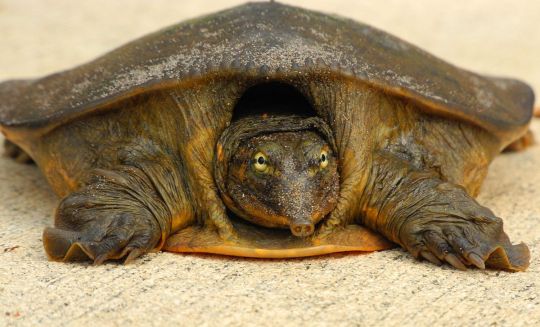
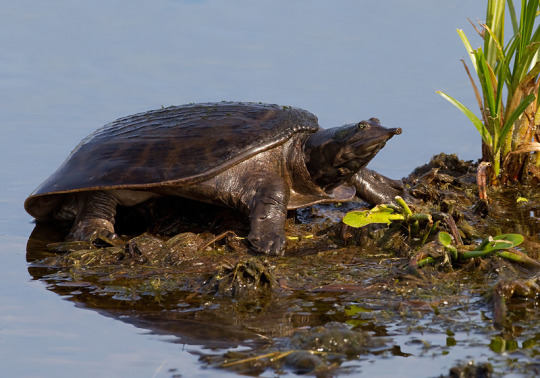

Feeling Out the Florida Softshell Turtle
The Florida softshell turtle (Apalone ferox) is a species of softshell turtle that resides only in the southeastern tropics of the United States, especially along the Atlantic Coast and the Gulf of Mexico. Within this range, they can be found in a number of freshwater environments, including ponds, lakes, swamps, marshes, and urban catchments; they may occasionally also occur in the mouths of slower moving rivers and streams. They generally prefer more muddy bottoms, in which they can bury themselvesand forage for food.
Florida softshell turtles have a highly varied diet, obtained through both active predation and scavenging. When hunting, they may bury themselves at the muddy lake bottom and wait for potential prey to come close enough for an ambush. They are largely carnivorous, feeding on fish, insects, crustaceans, frogs and mollusks, as well as the occasional aquatic plant. Adults are primary predated upon by alligators, while juveniles and eggs may fall prey to foxes, raccoons, birds, and large fish.
Although A. ferox is almost entirely aquatic, adults will readily move overland to find more suitable habitat. They are also frequently spotted basking on rocks or logs. Adults are highly aggressive, and will attack anything they percieve as a threat, including birds, fish, other turtles, and people. In addition to their ferocious bite, they also emit a foul-smelling musk to drive away potential predators.
Mating for the Florida softshell turtle occurs once a year, in the spring from March to July. After mating, females lay their eggs along river or lake banks in clutches of 9-24 eggs. Although they only mate once, females may lay anywhere from 2-7 clutches in a single year. Each clutch incubates for 56 to 80 days, and are immediately independent. Males reach maturity at only 2 years old, while females take 5-8 years; both sexes may live to be over 20 years old in the wild.
Although perhaps not the most attractive turtle, the A. ferox has a very striking appearance. They have a large, flattened body which is covered-- limbs and shell both-- in leathery, olive green or brown skin, with a lighter underside. The shell may also sport darker spots, which help the individual blend in to the muddy substrate. The head is specially distinctive, with a long neck and flattened skull, terminating in a pointed, tubular nose. Individuals may use their extended nostrils to breathe without exposing their body above water. Female Florida softshell turtles are much larger than males; 40.1 cm (15.8 in) in length and 6.65 kg (14.7 lb) compared to only 35 cm (14 in) and 2.68 kg (5.9 lb).
Conservation status: The Florida softshell turtle is considered Least Concern by the IUCN. However, they are threatened by harvesting for meat and the pet trade, as well as habitat loss.
If you like what I do, consider buying me a ko-fi!
Photos
Andrea Westmoreland
Paul Cools
J.D. Willson
#florida softshell turtle#Testudines#If you like what I do#consider buying me a ko-fi!#softshell turtles#turtles#reptiles#freshwater fauna#freshwater reptiles#wetlands#wetland reptiles#lakes#lake reptiles#north america#southern north america
89 notes
·
View notes
Text
VIDEOGAMECOWS ULTIMATE COW BREED SHOWDOWN: ROUND 1 POLL 7


BRAHMAN
a type of zebuine cattle from india, carrying their family's distinctive fatty hump and long ears! theyre super heat resistant and are popular in tropical regions!


CHIANINA
a massive, white breed of cattle from italy! they are absolutely HUGE, some even reaching over 2000 lbs!
#animals#cow#cows#cattle#silly#tournament poll#tournament polls#tumblr tournament#ultimate cow breed showdown
224 notes
·
View notes
Text
Wet Beast Wednesday: bluegill
This series goes all over the world; from the tropics to the poles to the deep sea. After all that, it can be nice to go home. For this Wet Beast Wednesday I'm going back to my spawnpoint of Illinois and discussing the state fish: the bluegill.

(Image: a bluegill underwater. It is a round fish flattened on the sides. It is green on the top ans fades to yellow on the sides. The underside of the chin is bright blue and behind the head is a bright orange patch. End ID)
Lepomis macrochirus is the most popular and famous of genus Lepomis, known as the sunfish or true sunfish (not to be confused with ocean sunfish). These fish are native to freshwater lakes, streams, wetlands, and rivers of North America and all share a fleshy ear flap extending from the operculum and are usually quite colorful. Bluegills are large for sunfish, which isn't saying much. Adults can reach and average of between 10 and 30 cm (4-12 in) and the largest bluegill on record reached a whopping 41 cm (16 cm) and was weighed in at 4 lbs 12 ox (2.2 kg). Bluegills and flattened and deep bodies with fused dorsal fins and spines in both the dorsal and anal fins that help prevent predation. The fish are brightly colored, but coloration varies widely based on size, diet, time of year, location, and many other factors. Because of this, two bluegill can look like completely different fish. Their bodies can range from dark green to orange, darkest on the top, and they usually have green faces with blue markings on the chin and bottom of the face that give them their common name. The "breast" region just below and behind the head ranges from yellow to orange and is usually a bright orange in mature males. A key feature is that the ear flap is black. Bluegills usually grow more brightly colored during mating season and less colorful other times of the year. There is a series of vertical stripes going down the side of the body that can quickly be darkened as a threat display.

(Image: a bluegill in a net with its stripes in full display. End ID)
Bluegill are skilled swimmers thanks to the shape and flexibility of their fins and the amount of fine control they have over them. This lets the fish maneuver gracefully through obstacles and confined spaces that other fish would struggle in and turn while not having to move forward. Bluegills are also one of a relatively few fish that are skilled at swimming backwards. This requires very different fin motion than swimming forwards. When swimming forwards, bluegills use their tail fin to provide thrust with the other fins helping with steering as is typical for fish. While swimming backwards, the dorsal and anal fins provide thrust while the pectoral fins are moved in a rowing motion to provide steering. Bluegills are also fast swimmers, their slender bodies allowing them to cut through the water at high speeds. Bluegills are also often used as an example when explaining the c-start escape response. This is a behavior found in tons of fish used to escape from danger. When the fish senses danger, a group of specialized neurons called Mauthner cells activate and control the escape response. The fish bends its body into a C shape. This shape allows for maximum thrust when it rapidly straightens its body out again for a speedy getaway. The c-start escape response is heavily customizable, allowing the fish to shoot off at nearly any angle it needs.
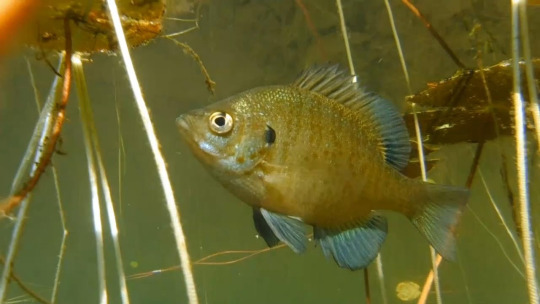
(Image: a young bluegill swimming amongst lilypads. It is not as round as the larger fish and its colors are more muted. End ID)
Bluegills are found in freshwater systems east of the Rocky Mountains (so most of North America) but they have been introduced west of the Rockies and to other parts of the world. They are very adaptable fish that can live in a wide variety of environments. It is probably easier to list bodies of water in North America that don't have bluegill than the other way around. They prefer to live in areas with cover, live brush, aquatic plants, and shady spots. Bluegill are diurnal predators that subsist on aquatic invertebrates like insect and crayfish larvae and worms, along with the occasional smaller fish. In times of famine, they will eat aquatic plants and algae or turn to cannibalism. Like many fish, bluegill feed through suction and they need to get within under 2 centimeters of they prey for the suction to be effective. Bluegills are also prey to larger predatory fish, turtles, birds, raccoons, and otters. Bluegill are mostly active in the morning and evening and will often move between feeding grounds and shelter during the day. They are reported to be aggressive to each other and other fish. Sighs of aggression include darkening their stripes, flaring their ear flaps, and biting.
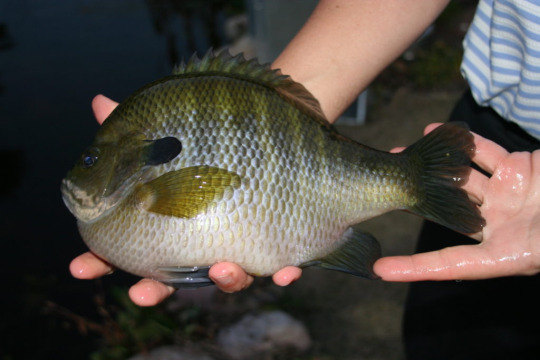
(Image: someone holding a very fat bluegill. End ID)
Bluegills mate in the summer between May and August. Males will build nests in rocky or sandy bottoms by clearing away sediment to expose hard surfaces. The nests are circular and 15 to 30 cm (6-12 in) in diameter and built in shallow water. Males will swim around their nest to try to attract females through displays and grunting noises. Females carefully analyze the male's displays and appear to prefer males with larger ear flaps. Once a female chooses a male, they will circle each other as the male acts aggressive. Once they meet in the middle of the nest the two will touch their underbellies together, with the male on top, and the female will lay her eggs as the male fertilizes them. The eggs sink into the nest and stick to hard surfaces. After mating, the male takes the kids in the divorce chases the female away and will guard the nest until the eggs hatch and the larvae swim away. During this period, the male will aggressively defend the nest against anything that comes near. They have been known to approach and bite snorkelers who get too close. Females can produce between 1,000 and 100,000 eggs depending on their size. Bluegill will mate multiple times each season. Larvae live in the shallows and feed on plankton. They grow rapidly for their first three years and then slow down. Bluegill can live up to 11 years, but usually live between 5 and 8 years.

(Image: bluegill nests seen from above. The nests are circular depressions filled with pebbles. Each nest has a male hovering over it. End ID)
Bluegill can hybridize with other sunfish, though this is rare in the wild. It usually happens when two sunfish species live in an area with limited nesting ground. The most common hybrid is with the green sunfish (Lepomis cyanellus) to produce an offspring called a greengill. Greengills are highly varied in appearance and typically between their parents in size. Most greengills seem to be the result of a male bluegill attracting and mating with a female green. Greengills were long thought to be stile as are most hybrids, but a least some second generation hybrids have been discovered. Greengills do have reduced fertility compared to their parent species. Another hybrid that is less commonly seen and not as well studied is the pumpkingill, a hybrid of bluegill and pumpkinseed (Lepomis gibbosus).
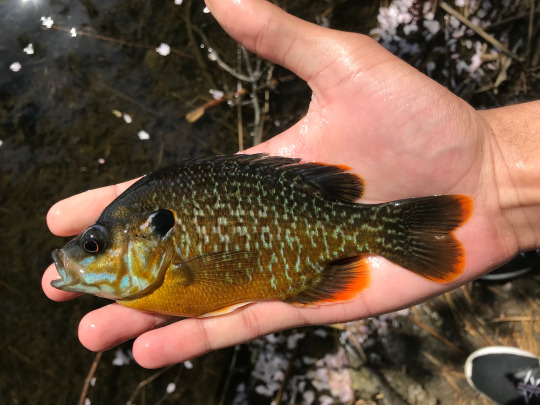
(Image: a greengill being held in someone's hand. It is more elongated than a bluegill and reatins the orange breast, blue chin, and black ear flap while being otherwise darker than most bluegills. End ID)
Bluegills are classified as least concern by the IUCN, meaning they are not in danger of extinction. Bluegills have been introduced to waters well outside of the native range by anglers and they have become an invasive species in multiple countries. They are banned from being imported in Germany and Japan because of how invasive they became. Bluegills are highly popular among anglers. They are small and easy enough to catch to be a good target for beginners and large bluegill are a good example of panfish, fish small enough to be cooked in a frying pan. Large males are particularly easy to catch due to their aggressive defense of their nest. Many places have very low populations of large males. Lakes and ponds are frequently stocked with captive-bred bluegill to attract anglers. Population management is important because bluegill can damage the local ecosystem if their numbers grow too large. They can also be introduced to ponds to try to help control aquatic insect populations. Bluegills have little fear of humans, especially in places where people feed them. I personally have been SCUBA diving in a quarry where people feed the fish and the bluegills swam right up to me. Bluegills that are very familiar with people are know to allow themselves to be pet. Bluegills can be kept in captivity, though they need large tanks and tend to be aggressive to other fish.

(Image: a larval bluegill. It is a long, white fish with small fins and a very large eye. A scale identified part of the tail as being 2000 micrometers long. End ID)
#wet beast wednesday#bluegill#sunfish#fish#fishposting#fishblr#freshwater fish#aquatic biology#biology#ecology#zoology#animal facts#informative#educational#image described
67 notes
·
View notes
Text
If you'll allow me to be cheesy for a moment, I just want to say that I love this lb so much 🥹
Nobody watches hockey in the tropical lands of Brazil, so I'm so so so grateful to all of you. Lb with all of you was more special to me than the actual game
25 notes
·
View notes
Text

shark of the day: tiger shark, galeocerdo curvier
------------------------------------------------------------
tiger sharks are the second largerst species of predatory shark behind the great white. they can grow to be about 7.5 metres(~24 ft) long and weigh nearly 1350 kg(~3000 lbs). tiger sharks are found in tropical and temperate waters around the globe, though they seem to be more common in the pacific ocean. they are aggressive predators, feeding on anything and everything that fits in their mouth including bony fish, other elasmobranchs, dolphins, sea turtles, cephalopods, and various non-living things including plastics, metal, and other garbage. due to their liberal feeding behaviour, they have earned the nickname garbage cans of the sea.
13 notes
·
View notes